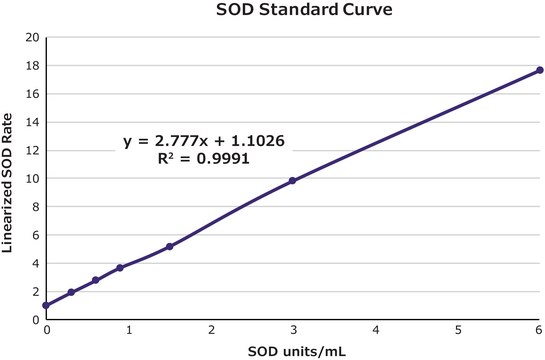Recommended Products
usage
sufficient for 50 tests
Quality Level
manufacturer/tradename
Calbiochem®
storage condition
OK to freeze
assay range
standard curve range: 0-2.5 mM
(plasma)
input
sample type serum
sample type plasma
sample type tissue extract(s)
sample type beverage(s)
sample type plant extract(s)
detection method
colorimetric
shipped in
ambient
storage temp.
2-8°C
General description
Components
Warning
Principle
Preparation Note
• Substrate: Dilute each vial of Substrate needed for the assay by adding 7.5 ml Buffer. After dilution, the substrate is stable for 24 h at 4°C. NOTE: Some automated methods do not require substrate dilution.
• Standard: Add 1 ml distilled water to each vial of Standard needed for the assay. After reconstitution, the Standard is stable for 2 days at 4°C or 1 month at -20°C.
Storage and Stability
Analysis Note
1. Determine the ΔA for the samples, standard, and blank. ΔA = A - Ao
2. Calculate the concentration of antioxidants in the sample using the formula below:
<div class="Bio_doc_image">Figure 2: Antioxidant Concentration Formula
</div>
NOTE: If the antioxidant concentration is greater than 2.5 mM dilute the sample with 0.9% NaCl and re-assay. Typical antioxidant levels in normal human plasma are 1.30-1.77 mM.
Other Notes
Legal Information
Signal Word
Warning
Hazard Statements
Precautionary Statements
Hazard Classifications
Eye Irrit. 2 - Skin Irrit. 2 - STOT SE 3
Target Organs
Respiratory system
Storage Class Code
10 - Combustible liquids
Certificates of Analysis (COA)
Search for Certificates of Analysis (COA) by entering the products Lot/Batch Number. Lot and Batch Numbers can be found on a product’s label following the words ‘Lot’ or ‘Batch’.
Already Own This Product?
Find documentation for the products that you have recently purchased in the Document Library.
Our team of scientists has experience in all areas of research including Life Science, Material Science, Chemical Synthesis, Chromatography, Analytical and many others.
Contact Technical Service

